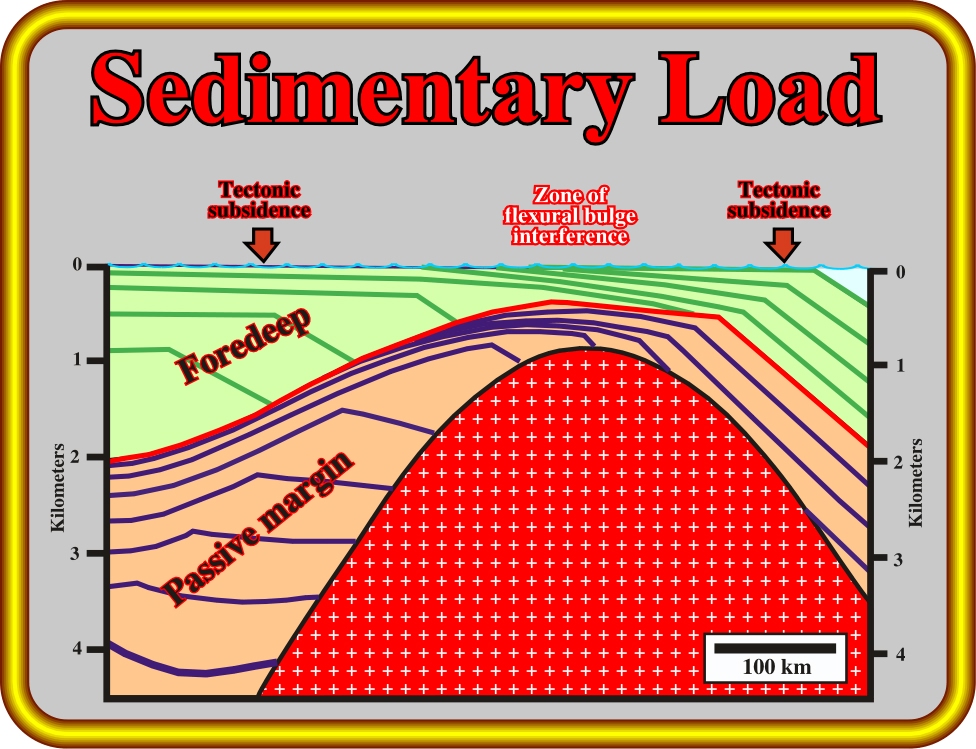
Universidade Fernando Pessoa
Porto, Portugal

Basic Principles in Foredeep & Foldbelt Basins
VII- Tectonic & Sedimentary Loadings
T. Watts proposed a stratigraphical model for a foredeep basin with two loads. Such a model is shown in fig. 12, where a divergent continental margin and a foredeep basin are illustrated.
One of the loads is due to the weight of the thrust and associated fold belt. The other is due to the thermal contraction, which normally follows the lengthening of the lithosphere.
The center of these loads is generally separated by more than 400 km. Such greater distance is the main reason for the uplift of the area between, which is the consequence of the interference of the anomalies induced by each load (fig. 8). The tectonic subsidence localized seaward of the peripheral bulge of the foredeep basin (fig. 12) displaces the sedimentary depocenters toward the craton, strongly decreasing the terrigeneous influx in the foredeep basin.

Fig. 12- Stratigraphic model of a foredeep basin assuming that it results from the superposition of two loads: (i) one due to the thrust/fold loading and (ii) the other due to thermal contraction of the lithosphere following rifting. This model implies that the sediments of the foredeep prograde from the fold belt toward the peripheral bulge, while the sediments of the divergent margin mainly aggrade with a depositional water depth more or less constant..
In the geological model illustrated in fig. 12, seaward of the peripheral bulge, it is easy to recognize the vertical stacking of two or even three different sedimentary basins:
(i) rift-type basins (not shown on the figure),
(ii) a divergent margin and(iii) a foredeep basin.
The cartography of the limits between these basins, particularly on seismic data, is very often difficult for young explorationists to see. However, taking into account that they correspond to genetic changes of the subsidence (lengthening, thermal contraction and flexural), they can be recognized indirectly.
A priori, one can say:
a) When the subsidence is due to lengthening (rift-type basins), the sedimentary fill is mainly non-marine and, at seismic scale, it is mainly aggradational (13).
(13) The progradation of a deltaic depositional system is probably the more simple geological mechanism of infilling. However, on conventional seismic data, the depositional sedimentary breaks associated with the deltaic progradation are almost always under the seismic resolution.
b) In the divergent margins (thermal contraction), the sedimentary infilling is mainly aggradational, i.e. the internal configuration geometry is chiefly aggradational rather than progradational (14).
(14) The progradation of a deltaic depositional system is probably the more simple geological mechanism of infilling. However, on conventional seismic data, the depositional sedimentary breaks associated with the deltaic progradation are almost always under the seismic resolution.
c) When the subsidence is flexural, there is formation of sedimentary prisms. Their progradation depending on tectonic loading. Only in the proximal and deep areas of the foredeep basins, i.e. in the turbiditic realms, is the geometry aggradational.
On seismic data, the lower limit of the foredeep basins, i.e. at the onset of the flexural subsidence, is underlain by a major downlap surface, which is seen as distal reflection terminations as the successive sedimentary prisms prograde way from the fold belt.